A Rheological Model for Evaluating the Behavior of Shear Thickening of Highly Flowable Mortar
Abstract
1. Introduction
2. Literature Study
2.1. Theory of Shear Thickening
2.1.1. Cluster Formation
2.1.2. Grain Inertia
2.1.3. A More Reasonable Theory of Shear Thickening of Highly Flowable Mortar
2.2. Couette Inverse Problem
3. A Nonlinear Rheological Model for Highly Flowable Mortar
3.1. The New Rheological Model
3.2. The Solution of the Couette Inverse Problem
3.3. Comparison Among Other Rheological Models
4. Materials and Experimental Methods
4.1. Raw Materials
4.2. Mix Proportion
4.3. Mortar Preparation
4.4. Rheometer and Protocol
5. Results and Discussion
5.1. Relationship between Rotational Speed and Torque
5.2. Determination of Three Parameters in the New Rheological Model
5.3. Relationship between Shear Stress and Shear Strain Rate
5.4. Relationship between Differential Viscosity and Shear Stress of Mortars
6. Conclusions
Author Contributions
Funding
Data Availability Statement
Acknowledgments
Conflicts of Interest
Sample Availability
References
- Secrieru, E.; Cotardo, D.; Mechtcherine, V.; Lohaus, L.; Schröfl, C.; Begemann, C. Changes in concrete properties during pumping and formation of lubricating material under pressure. Cem. Concr. Res. 2018, 108, 129–139. [Google Scholar] [CrossRef]
- Le, H.D.; Kadri, E.H.; Aggoun, S.; Vierendeels, J.; Troch, P.; De Schutter, G. Effect of lubrication layer on velocity profile of concrete in a pumping pipe. Mater. Struct. 2015, 48, 3991–4003. [Google Scholar] [CrossRef]
- Feys, D.; Khayat, K.H.; Perez-Schell, A.; Khatib, R. Development of a tribometer to characterize lubrication layer properties of self-consolidating concrete. Cem. Concr. Compos. 2014, 54, 40–52. [Google Scholar] [CrossRef]
- Moorthi, P.V.P.; Mio, F.P.; Nanthagopalan, P.; Ferrara, L. Onset and intensity of shear thickening in cementitious sus-pensions—A parametrical study. Constr. Build. Mater. 2020, 244, 118292. [Google Scholar] [CrossRef]
- Ma, K.; Feng, J.; Long, G.; Xie, Y. Effects of mineral admixtures on shear thickening of cement paste. Constr. Build. Mater. 2016, 126, 609–616. [Google Scholar] [CrossRef]
- Kaplan, D.; de Larard, F.; Sedran, T. Design of Concrete pumping circuit. ACI Mater. J. 2005, 102, 110–117. [Google Scholar]
- Kwon, S.H.; Jang, K.P.; Kim, J.H.; Shah, S.P. State of the Art on Prediction of Concrete Pumping. Int. J. Concr. Struct. Mater. 2016, 10, 75–85. [Google Scholar] [CrossRef]
- Kim, J.S.; Kwon, S.H.; Jang, K.P.; Choi, M.S. Concrete pumping prediction considering different measurement of the rhe-ological properties. Constr. Build. Mater. 2018, 171, 493–503. [Google Scholar] [CrossRef]
- Feys, D.; De Schutter, G.; Verhoeven, R. Parameters influencing pressure during pumping of self-compacting concrete. Mater. Struct. 2012, 46, 533–555. [Google Scholar] [CrossRef]
- Varchanis, S.; Makrigiorgos, G.; Moschopoulos, P.; Dimakopoulos, Y.; Tsamopoulos, J. Modeling the rheology of thixotropic elasto-visco-plastic materials. J. Rheol. 2019, 63, 609–639. [Google Scholar] [CrossRef]
- Giannokostas, K.; Moschopoulos, P.; Varchanis, S.; Dimakopoulos, Y.; Tsamopoulos, J. Advanced Constitutive Modeling of the Thixotropic Elasto-Visco-Plastic Behavior of Blood: Description of the Model and Rheological Predictions. Materials 2020, 13, 4184. [Google Scholar] [CrossRef]
- Gillissen, J.J.J.; Ness, C.; Peterson, J.D.; Wilson, H.J.; Cates, M.E. Constitutive model for shear-thickening suspensions: Predictions for steady shear with superposed transverse oscillations. J. Rheol. 2020, 64, 353–365. [Google Scholar] [CrossRef]
- Gillissen, J.J.J.; Ness, C.; Peterson, J.D.; Wilson, H.J.; Cates, M.E. Constitutive Model for Time-Dependent Flows of Shear-Thickening Suspensions. Phys. Rev. Lett. 2019, 123, 214504. [Google Scholar] [CrossRef] [PubMed]
- Feys, D.; Verhoeven, R.; De Schutter, G. Why is fresh self-compacting concrete shear thickening? Cem. Concr. Res. 2009, 39, 510–523. [Google Scholar] [CrossRef]
- Li, M.; Han, J.; Liu, Y.; Yan, P. Integration approach to solve the Couette inverse problem based on nonlinear rheological models in a coaxial cylinder rheometer. J. Rheol. 2019, 63, 55–62. [Google Scholar] [CrossRef]
- Rahman, M.; Håkansson, U.; Wiklund, J. In-line rheological measurements of cement grouts: Effects of water/cement ratio and hydration. Tunn. Undergr. Space Technol. 2015, 45, 34–42. [Google Scholar] [CrossRef]
- Rahman, M. Rheology of Cement Grouts—Ultrasound Based in-Line Measurement Technique and Grouting Design Parameters. Ph.D. Thesis, KTH Royal Institute of Technology, Stockholm, Sweden, 2015. [Google Scholar]
- Maybury, J.; Ho, J.; Binhowimal, S. Fillers to lessen shear thickening of cement powder paste. Constr. Build. Mater. 2017, 142, 268–279. [Google Scholar] [CrossRef]
- Cyr, M.; Legrand, C.; Mouret, M. Study of the shear thickening effect of superplasticizers on the rheological behavior of cement pastes containing or not mineral additives. Cem. Concr. Res. 2000, 30, 1477–1483. [Google Scholar] [CrossRef]
- Hosseinpoor, M.; Koura, B.O.; Yahia, A. New methodology to evaluate the Reynolds dilatancy of self-consolidating con-crete using 3D image analysis—Coupled effect of characteristics of fine mortar and granular skeleton. Cem. Concr. Compos. 2020, 108, 103547. [Google Scholar] [CrossRef]
- Mohammed, A.; Mahmood, W.; Ghafor, K. TGA, rheological properties with maximum shear stress and compressive strength of cement-based grout modified with polycarboxylate polymers. Constr. Build. Mater. 2020, 235, 117534. [Google Scholar] [CrossRef]
- Vipulanandan, C.; Mohammed, A. Hyperbolic rheological model with shear stress limit for acrylamide polymer modified bentonite drilling muds. J. Pet. Sci. Eng. 2014, 122, 38–47. [Google Scholar] [CrossRef]
- Choi, M.; Roussel, N.; Kim, Y.; Kim, J. Lubrication layer properties during concrete pumping. Cem. Concr. Res. 2013, 45, 69–78. [Google Scholar] [CrossRef]
- Salinas, A.; Feys, D. Estimation of Lubrication Layer Thickness and Composition through Reverse Engineering of Interface Rheometry Tests. Materials 2020, 13, 1799. [Google Scholar] [CrossRef] [PubMed]
- Yan, P.; Li, M.; Han, J.; Zhao, X. Recent development on pumpability of fresh concrete. J. Chin. Ceram. Soc. 2018, 46, 239–246. (In Chinese) [Google Scholar]
- Chen, C.-L.; Ling, C.-H. Granular-Flow Rheology: Role of Shear-Rate Number in Transition Regime. J. Eng. Mech. 1996, 122, 469–480. [Google Scholar] [CrossRef]
- Savage, S.B.; Sayed, M. Stresses developed by dry cohensionless granular materials sheared in an annular shear cell. J. Fluid. Mech. 1984, 142, 391–430. [Google Scholar] [CrossRef]
- Wallevik, O.H.; Feys, D.; Wallevik, J.E.; Khayat, K.H. Avoiding inaccurate interpretations of rheological measurements for cement-based materials. Cem. Concr. Res. 2015, 78, 100–109. [Google Scholar] [CrossRef]
- Li, M.; Liu, Y.; Han, J.; Yan, P. Calculation of rheological parameters of cement-based materials based on solution to the Couette inverse problem. J. Chin. Ceram. Soc. 2020, 48, 1302–1309. (In Chinese) [Google Scholar]
- Palagallo, J.A.; Price, T.E. Some remarks on the evaluation of ∫dt/(tm+1). Math. Mag. 1997, 70, 59–63. [Google Scholar]
- Qian, Y.; Kawashima, S. Distinguishing dynamic and static yield stress of fresh cement mortars through thixotropy. Cem. Concr. Compos. 2018, 86, 288–296. [Google Scholar] [CrossRef]
- Jiao, D.; Shi, C.; Yuan, Q.; An, X.; Liu, Y.; Li, H. Effect of constituents on rheological properties of fresh concrete-A review. Cem. Concr. Compos. 2017, 83, 146–159. [Google Scholar] [CrossRef]
- Barnes, H.A. Shear-thickening (“Dilatancy”) in suspensions of nonaggregating solid particles dispersed in Newtonian liquids. J. Rheol. 1989, 33, 329–366. [Google Scholar] [CrossRef]
- Maranzano, B.J.; Wagner, N.J. The effects of particle size on reversible shear thickening of concentrated colloidal disper-sions. J. Chem. Phys. 2001, 114, 10514–10527. [Google Scholar] [CrossRef]
- Maranzano, B.J.; Wagner, N.J. The effects of interparticle interactions and particle size on reversible shear thickening: Hard-sphere colloidal dispersions. J. Rheol. 2001, 45, 1205–1222. [Google Scholar] [CrossRef]
- Egres, R.G.; Wagner, N.J. The rheology and microstructure of acicular precipitated calcium carbonate colloidal suspensions through the shear thickening transition. J. Rheol. 2005, 49, 719–746. [Google Scholar] [CrossRef]
- Egres, R.G.; Nettesheim, F.; Wagner, N.J. Rheo-SANS investigation of acicular-precipitated calcium carbonate colloidal suspensions through the shear thickening transition. J. Rheol. 2006, 50, 685–709. [Google Scholar] [CrossRef]
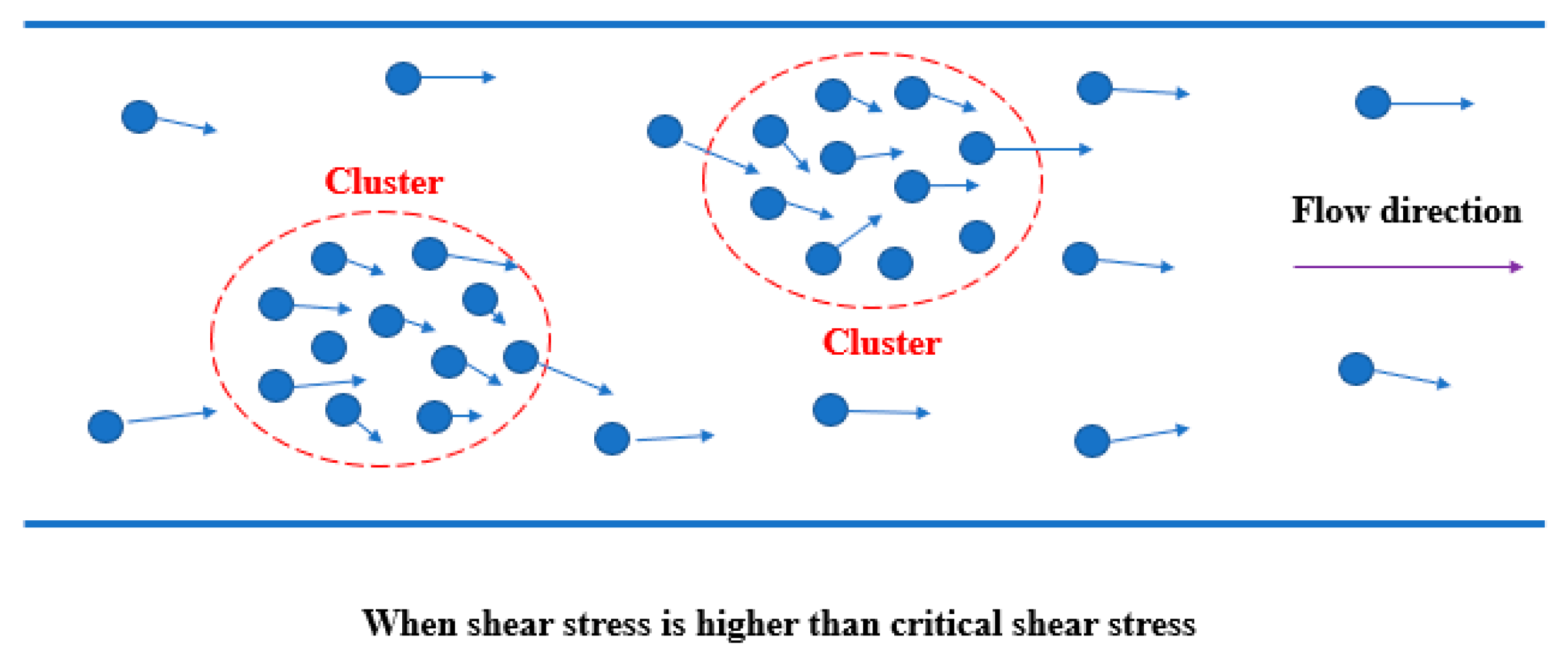
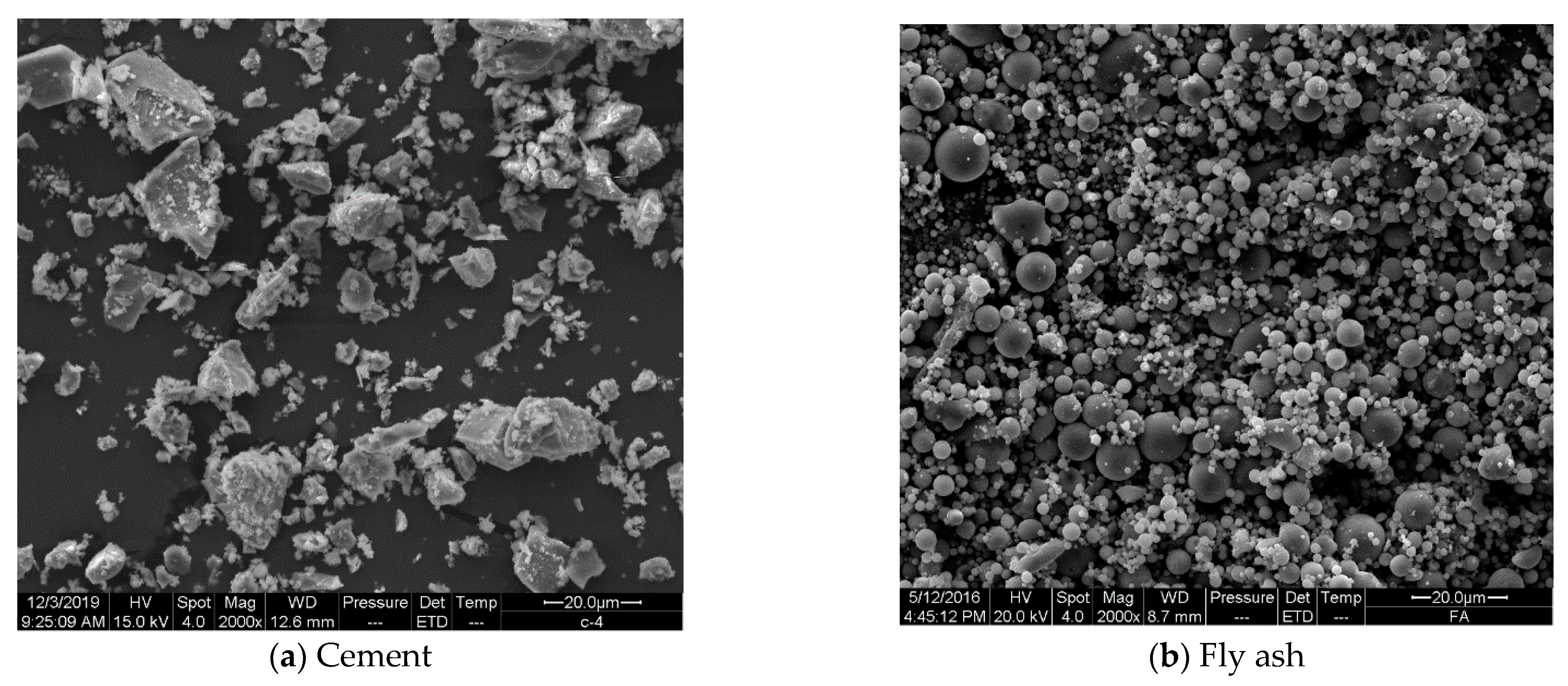
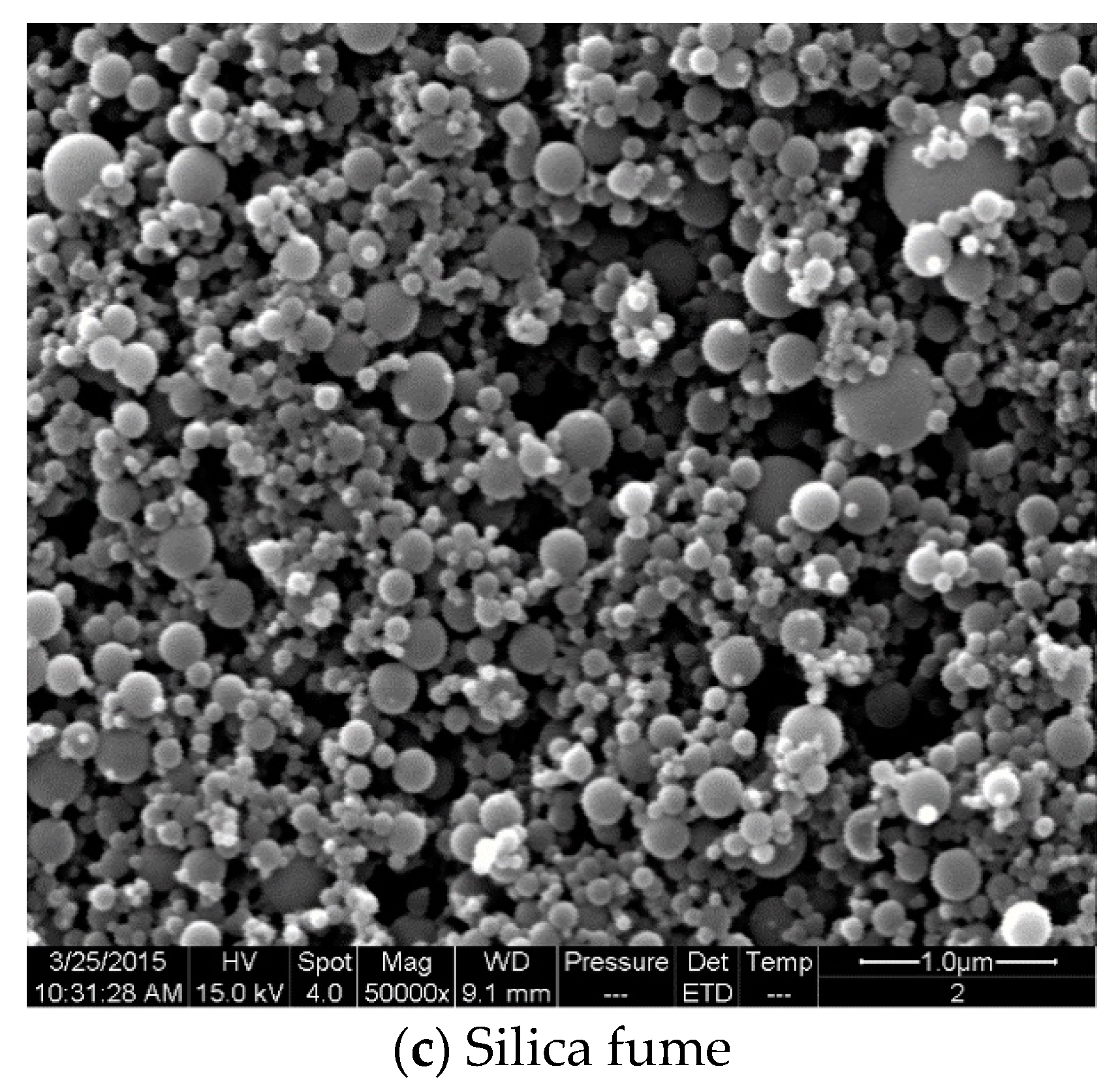


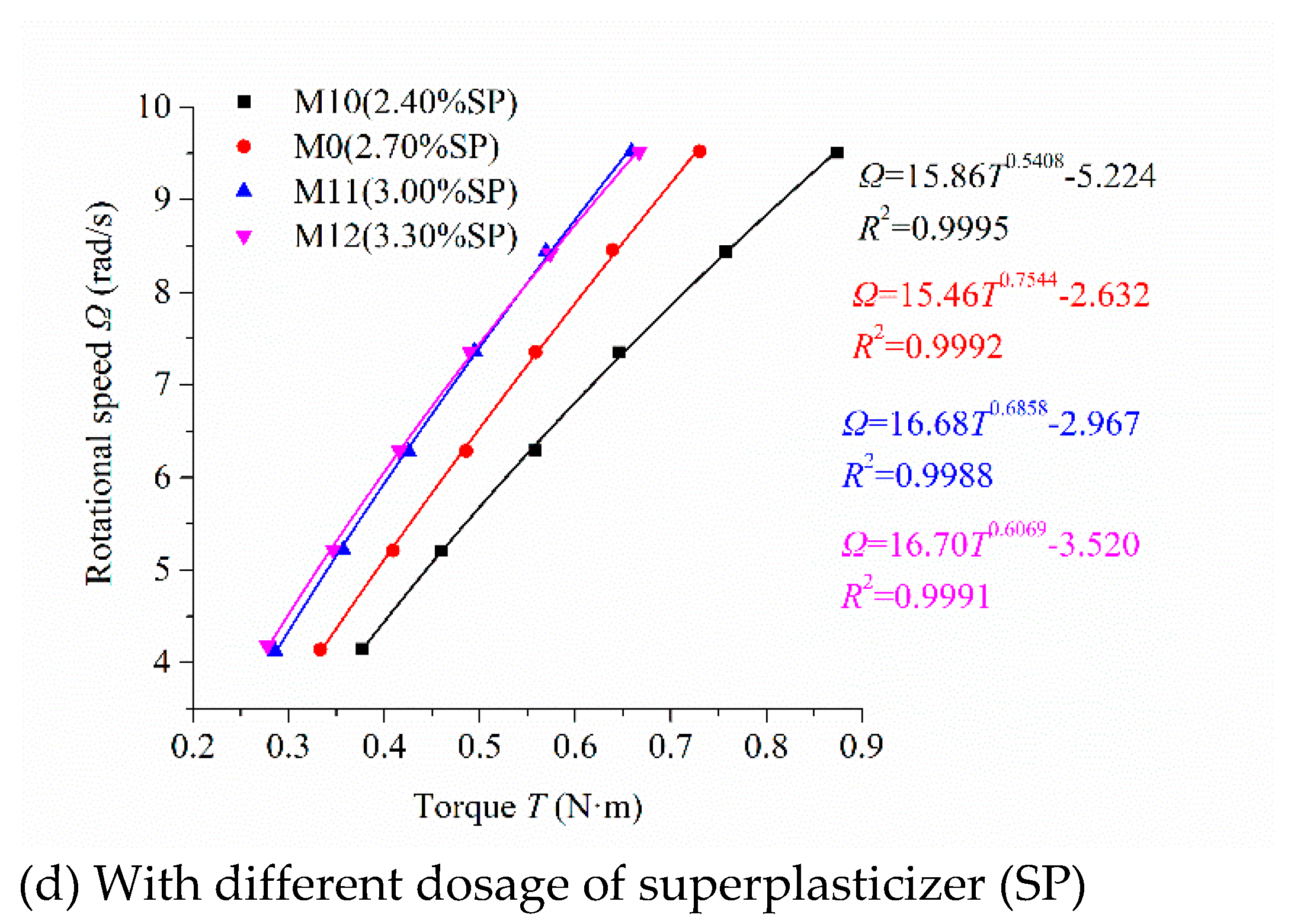
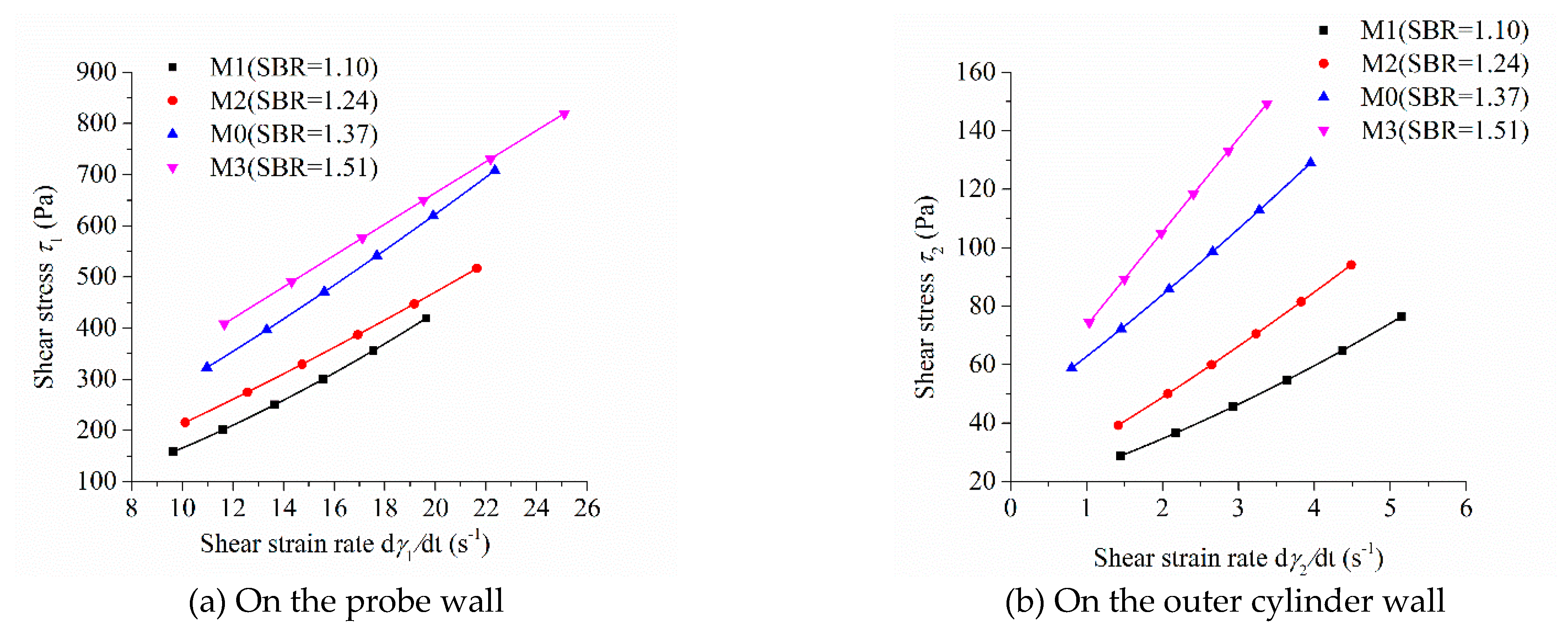

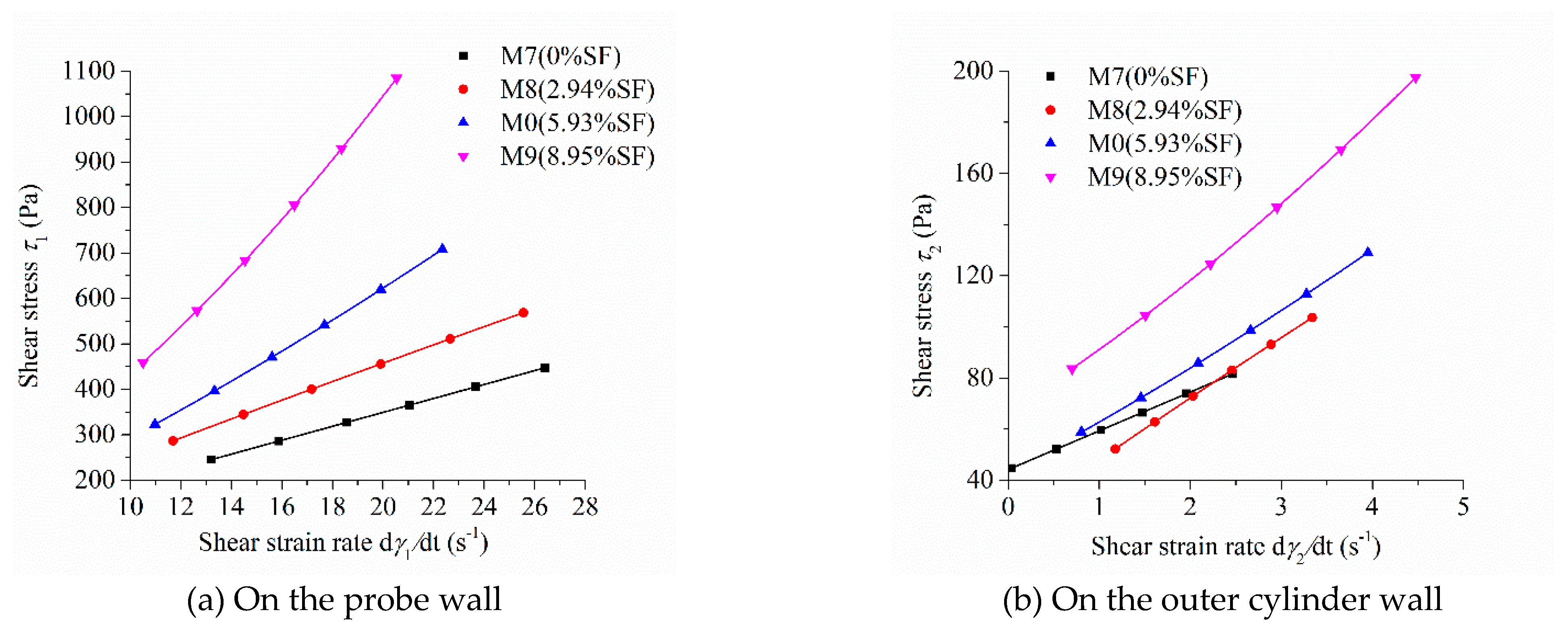
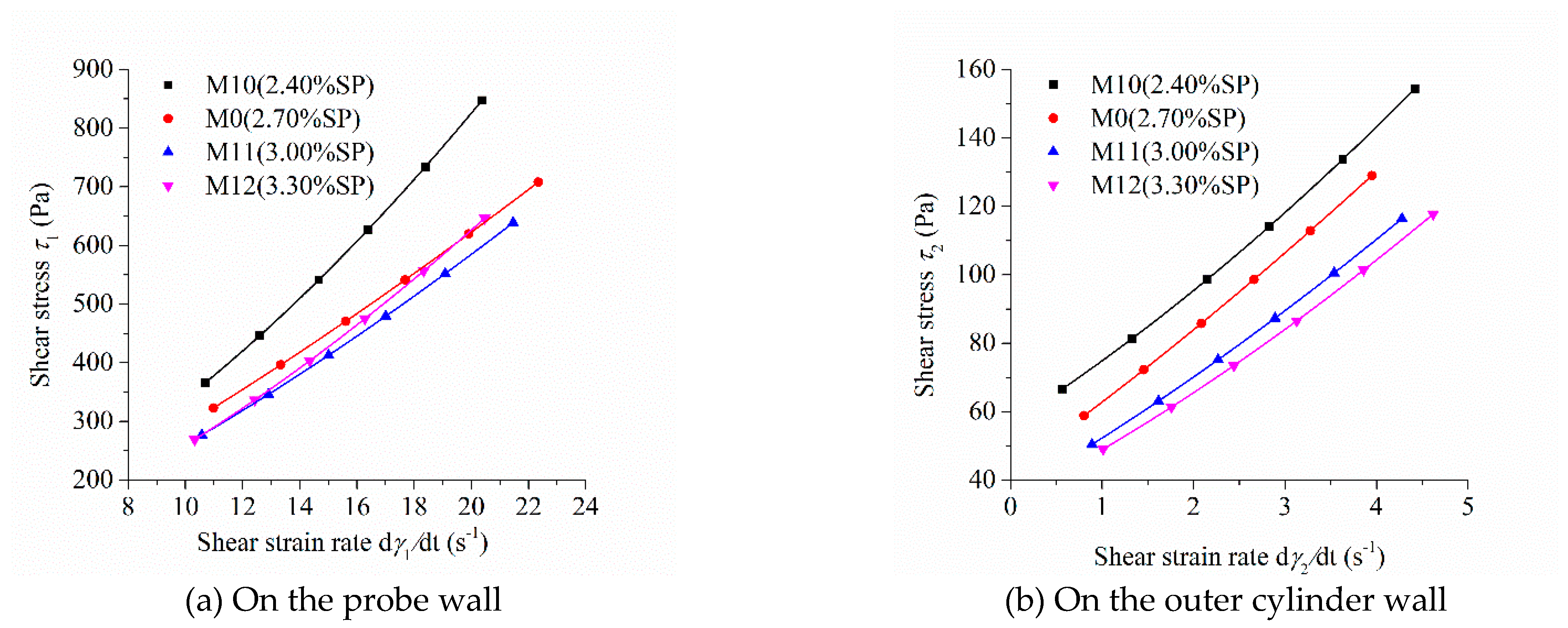
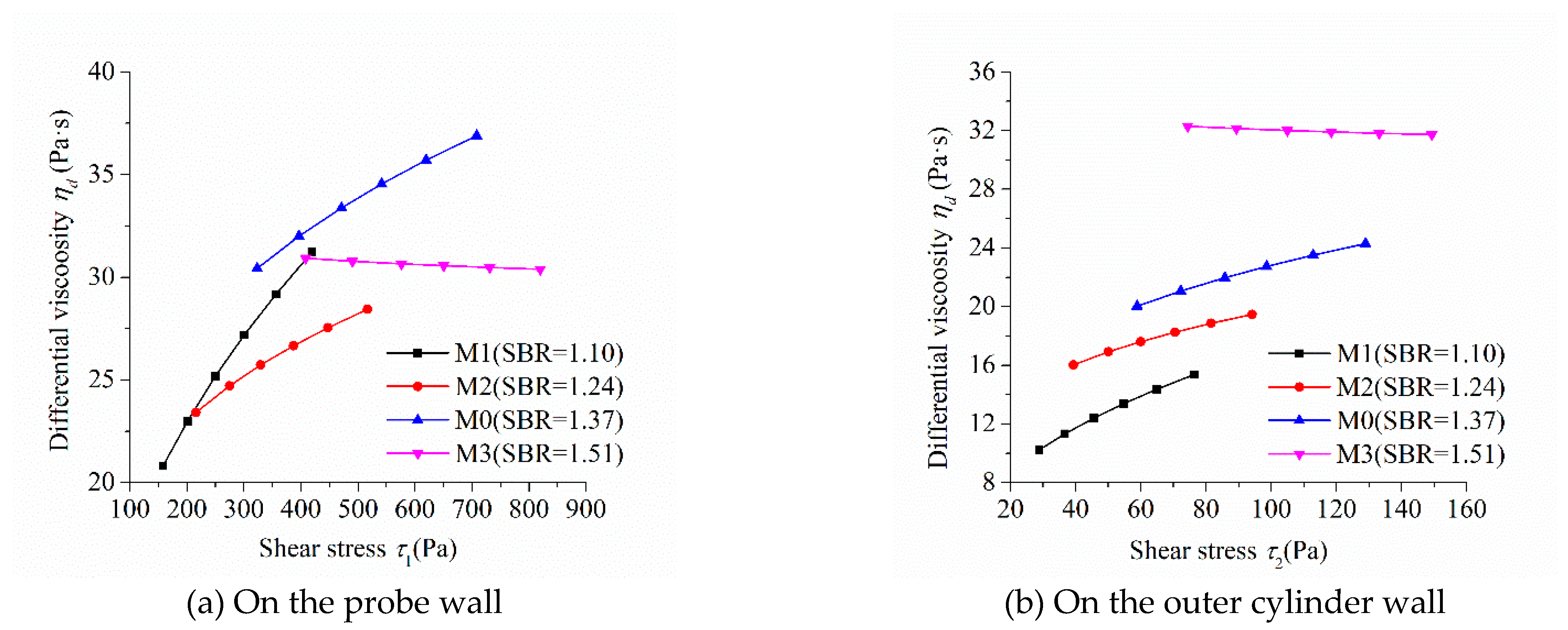
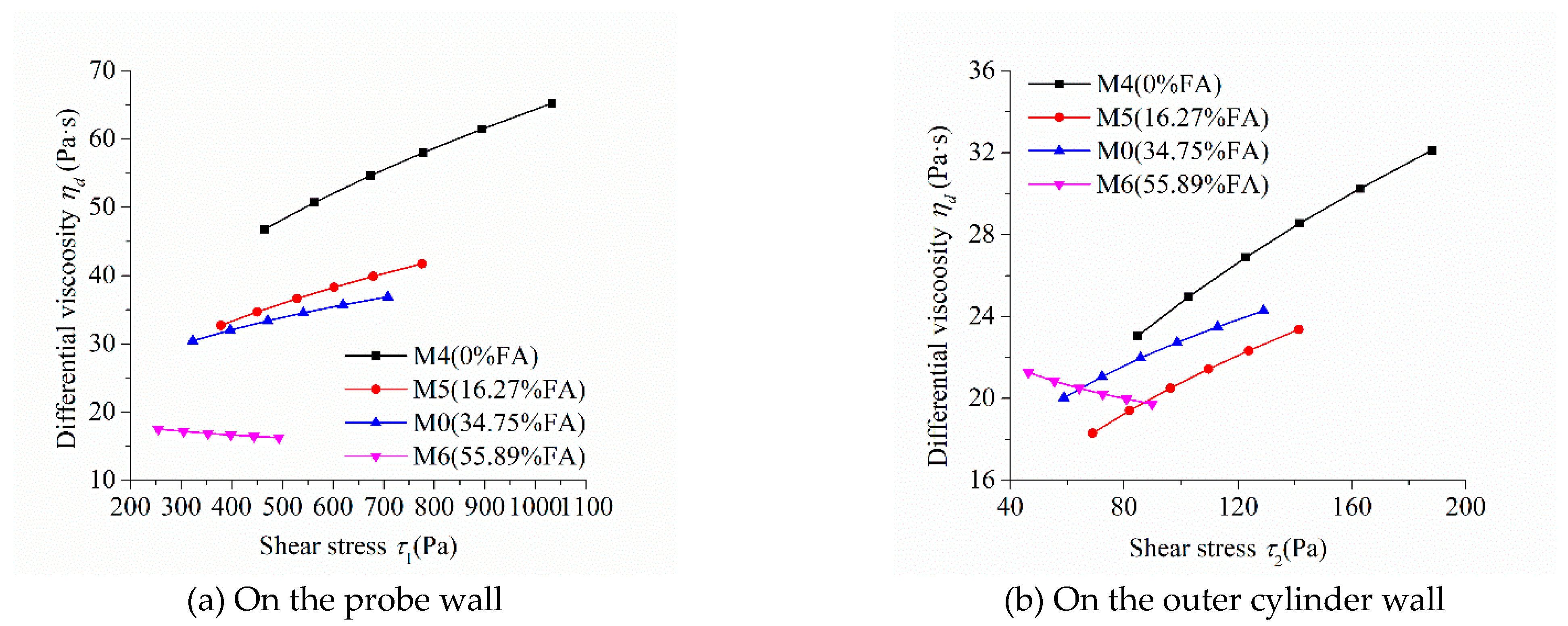
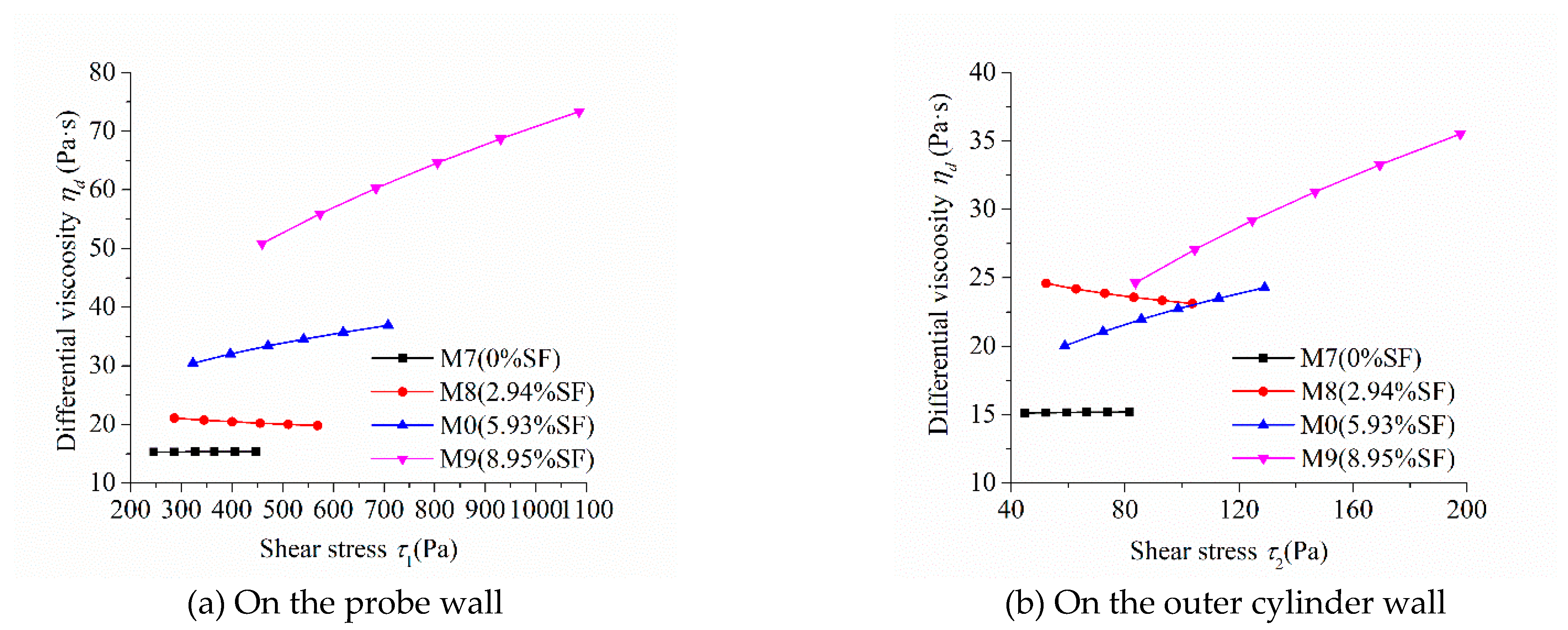
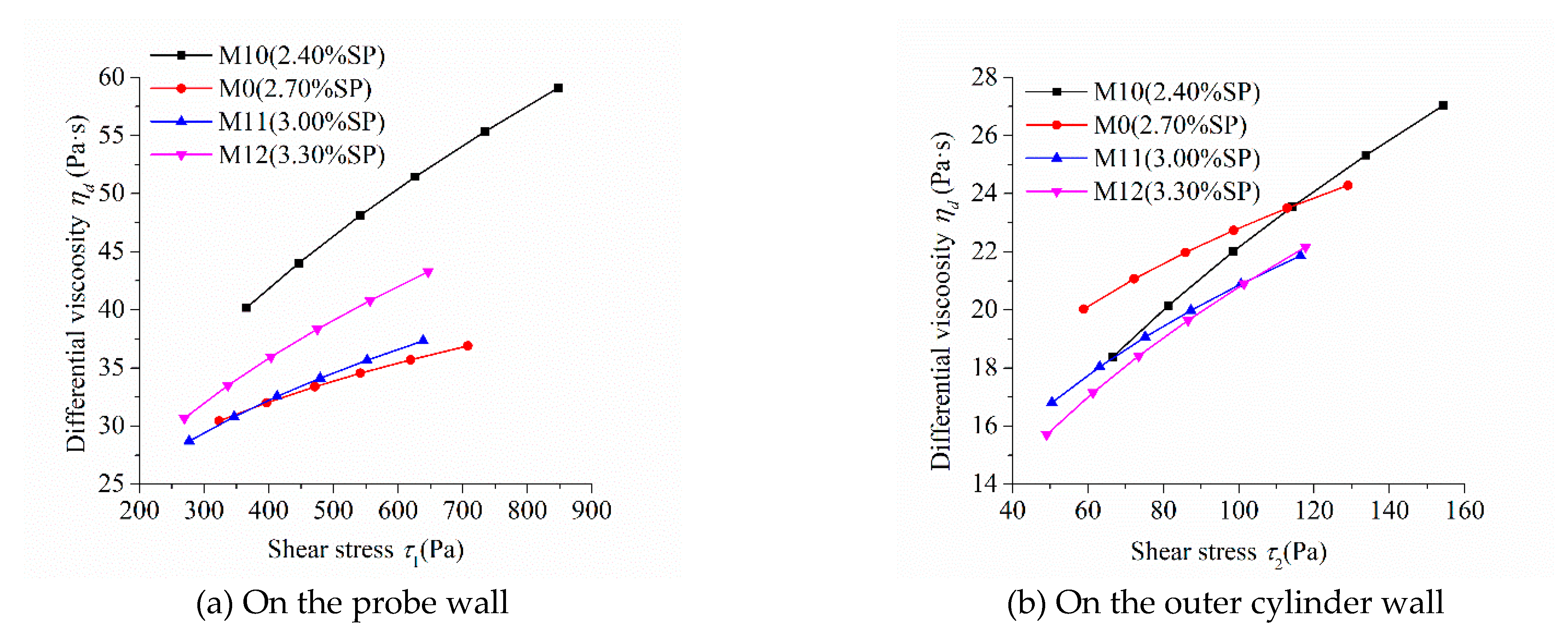
| Composition | Cement | FA | SF |
|---|---|---|---|
| SiO2 | 15.73 | 46.67 | 96.36 |
| Al2O3 | 3.31 | 34.66 | 0.33 |
| Fe2O3 | 4.14 | 6.13 | 0.05 |
| CaO | 70.36 | 6.28 | 0.58 |
| MgO | 1.38 | 0.81 | 0.34 |
| SO3 | 3.47 | 0.80 | 1.05 |
| Na2Oeq | 0.55 | 1.19 | 0.86 |
| Total | 98.94 | 96.54 | 99.57 |
| Sample | Composition of Binders/% | SBR | W/B | SP/% | ||
|---|---|---|---|---|---|---|
| Cement | FA | SF | ||||
| M0 (Control group) | 59.32 | 34.75 | 5.93 | 1.37 | 0.25 | 2.70 |
| M1 (SBR = 1.10) | 59.32 | 34.75 | 5.93 | 1.10 | 0.25 | 2.70 |
| M2 (SBR = 1.24) | 59.32 | 34.75 | 5.93 | 1.24 | 0.25 | 2.70 |
| M3 (SBR = 1.51) | 59.32 | 34.75 | 5.93 | 1.51 | 0.25 | 2.70 |
| M4 (0% FA) | 90.91 | 0.00 | 9.09 | 1.37 | 0.25 | 2.70 |
| M5 (16.27% FA) | 76.12 | 16.27 | 7.61 | 1.37 | 0.25 | 2.70 |
| M6 (55.89% FA) | 40.10 | 55.89 | 4.01 | 1.37 | 0.25 | 2.70 |
| M7 (0% SF) | 63.10 | 36.90 | 0.00 | 1.37 | 0.25 | 2.70 |
| M8 (2.94% SF) | 61.24 | 35.81 | 2.94 | 1.37 | 0.25 | 2.70 |
| M9 (8.95% SF) | 57.45 | 33.60 | 8.95 | 1.37 | 0.25 | 2.70 |
| M10 (2.40% SP) | 59.32 | 34.75 | 5.93 | 1.37 | 0.25 | 2.40 |
| M11 (3.00% SP) | 59.32 | 34.75 | 5.93 | 1.37 | 0.25 | 3.00 |
| M12 (3.30% SP) | 59.32 | 34.75 | 5.93 | 1.37 | 0.25 | 3.30 |
| Row Number | Sample | Yield Stress τ0 (Pa) | Consistency Coefficient κ (Pa·sn) | Consistency Exponent n (-) |
|---|---|---|---|---|
| 2 | M1 (SBR = 1.10) | 15.63 | 1.94 | 1.71 |
| 3 | M2 (SBR = 1.24) | 18.25 | 8.96 | 1.29 |
| 4 | M0 (SBR = 1.37) | 43.32 | 9.71 | 1.33 |
| 5 | M3 (SBR = 1.51) | 40.81 | 33.79 | 0.98 |
| 6 | M4 (0% FA) | 76.54 | 3.62 | 1.71 |
| 7 | M5 (16.27% FA) | 68.72 | 4.90 | 1.52 |
| 8 | M0 (34.75% FA) | 43.32 | 9.71 | 1.33 |
| 9 | M6 (55.89% FA) | 25.34 | 25.38 | 0.90 |
| 10 | M7 (0% SF) | 44.22 | 14.94 | 1.01 |
| 11 | M8 (2.94% SF) | 22.41 | 28.34 | 0.92 |
| 12 | M0 (5.93% SF) | 43.32 | 9.71 | 1.33 |
| 13 | M9 (8.95% SF) | 67.19 | 3.78 | 1.74 |
| 14 | M10 (2.40% SP) | 56.63 | 1.98 | 1.85 |
| 15 | M0 (2.70% SP) | 43.32 | 9.71 | 1.33 |
| 16 | M11 (3.00% SP) | 36.20 | 5.86 | 1.46 |
| 17 | M12 (3.30% SP) | 34.22 | 3.30 | 1.65 |
| Row Number | Sample | Rheological Expression |
|---|---|---|
| 2 | M1 (SBR = 1.10) | |
| 3 | M2 (SBR = 1.24) | |
| 4 | M0 (SBR = 1.37) | |
| 5 | M3 (SBR = 1.51) | |
| 6 | M4 (0% FA) | |
| 7 | M5 (16.27% FA) | |
| 8 | M0 (34.75% FA) | |
| 9 | M6 (55.89% FA) | |
| 10 | M7 (0% SF) | |
| 11 | M8 (2.94% SF) | |
| 12 | M0 (5.93% SF) | |
| 13 | M9 (8.95% SF) | |
| 14 | M10 (2.40% SP) | |
| 15 | M0 (2.70% SP) | |
| 16 | M11 (3.00% SP) | |
| 17 | M12 (3.30% SP) |
Publisher’s Note: MDPI stays neutral with regard to jurisdictional claims in published maps and institutional affiliations. |
© 2021 by the authors. Licensee MDPI, Basel, Switzerland. This article is an open access article distributed under the terms and conditions of the Creative Commons Attribution (CC BY) license (http://creativecommons.org/licenses/by/4.0/).
Share and Cite
Li, M.; Han, J.; Zhou, Y.; Yan, P. A Rheological Model for Evaluating the Behavior of Shear Thickening of Highly Flowable Mortar. Molecules 2021, 26, 1011. https://doi.org/10.3390/molecules26041011
Li M, Han J, Zhou Y, Yan P. A Rheological Model for Evaluating the Behavior of Shear Thickening of Highly Flowable Mortar. Molecules. 2021; 26(4):1011. https://doi.org/10.3390/molecules26041011
Chicago/Turabian StyleLi, Mengyuan, Jianguo Han, Yuqi Zhou, and Peiyu Yan. 2021. "A Rheological Model for Evaluating the Behavior of Shear Thickening of Highly Flowable Mortar" Molecules 26, no. 4: 1011. https://doi.org/10.3390/molecules26041011
APA StyleLi, M., Han, J., Zhou, Y., & Yan, P. (2021). A Rheological Model for Evaluating the Behavior of Shear Thickening of Highly Flowable Mortar. Molecules, 26(4), 1011. https://doi.org/10.3390/molecules26041011








